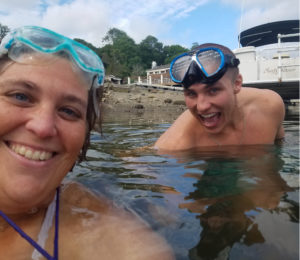Summer is winding down quickly, and as I prepare to embark on my study abroad experience at the Center for Marine Research at Turks and Caicos, I am finding it so difficult to leave the NSRWA. One might wonder why I am so saddened to end my summer internship at the watershed, as I am about to spend three months studying and researching in the clear Caribbean waters of T&C, but without the experience and skills I acquired working here with these wonderful people, I do not think I would be able to head south for the semester with comfort or peace of mind.
 Shadowing watershed ecologist Sara Grady was one of the many highlights of working at the watershed this summer. The field work we conducted together laid the foundation for any future field work I may take part in, whether at the Center in Turks and Caicos, at Denison University, or in my (hopeful) future career in marine conservation. The field work I was involved in with Sara this summer was diverse and meaningful; I worked on herring counts, installed a fish ladder camera (and intently viewed the footage), took vegetation, horseshoe crab, and invasive species surveys, trapped green crabs, went on a mussel dive, and learned how to take water samples and test water quality, all thanks to Sara’s guidance and teaching. I now feel confident in my abilities to “do science” in many diverse in-the-field scenarios. One of the most memorable experiences Sara and I shared was electrofishing in the Third Herring Brook. We worked with the Department of Fish and Game to sample as many fish and eels as we could in the brook, using an electrical current to momentarily stun the fish, then quickly catching them with nets and weighing and measuring them. While we worked our way through the brook in our rubber waders, sweaty and a little sore, nets at the ready, I realized that this was the type of work I want to be a part of the rest of my life. I want to thank Sara for being such a terrific mentor and friend. I will always remember harmonizing songs in our numerous car rides to different sites along the watershed.
Shadowing watershed ecologist Sara Grady was one of the many highlights of working at the watershed this summer. The field work we conducted together laid the foundation for any future field work I may take part in, whether at the Center in Turks and Caicos, at Denison University, or in my (hopeful) future career in marine conservation. The field work I was involved in with Sara this summer was diverse and meaningful; I worked on herring counts, installed a fish ladder camera (and intently viewed the footage), took vegetation, horseshoe crab, and invasive species surveys, trapped green crabs, went on a mussel dive, and learned how to take water samples and test water quality, all thanks to Sara’s guidance and teaching. I now feel confident in my abilities to “do science” in many diverse in-the-field scenarios. One of the most memorable experiences Sara and I shared was electrofishing in the Third Herring Brook. We worked with the Department of Fish and Game to sample as many fish and eels as we could in the brook, using an electrical current to momentarily stun the fish, then quickly catching them with nets and weighing and measuring them. While we worked our way through the brook in our rubber waders, sweaty and a little sore, nets at the ready, I realized that this was the type of work I want to be a part of the rest of my life. I want to thank Sara for being such a terrific mentor and friend. I will always remember harmonizing songs in our numerous car rides to different sites along the watershed.
Besides the time I spend in the field, I also worked on various projects and learned about the inner-workings of an environmental non-profit with Sam, Lori, Kate, and Gab. These four individuals made interning at the watershed a wonderful and entertaining experience. Releasing monarch and swallowtail butterflies that Lori had raised was just one highlight of my time spent in the office. I also became very familiar with the basement as Lori, Kate, Sam, Sara and I tackled the difficult task of cleaning and reorganizing it. One of my favorite programs was River Adventures. Every Tuesday morning, I would head to the YMCA and give a brief orientation of the watershed to elementary and middle school-aged children who were participating in a week-long program bringing them to various points of interest along the North and South Rivers, such as the Spit and Luddam’s Ford. I was inspired by the curiosity of the campers. They always wanted to know more about the watershed and how it worked, and when I returned on Friday afternoons to see how they enjoyed the week and make them honorary “members” of the NSRWA, they were ecstatic to tell me about the turtles, crabs, fish, and birds that they had seen, and all of the fun they had had in and around the watershed.
Interning for the watershed has been absolutely amazing. Although sometimes I felt overwhelmed, simply because the NSRWA takes on so many projects and is involved in a multitude of environmental conservation initiatives, every day I would head home having learned something new about the watershed or about the people who live and work on it. As I continue to pursue an education and career in environmental studies and conservation, I believe what I learned here will become more and more valuable. I am grateful for the friendships and connections I have made here, and look forward to working with the NSRWA in the future.
